
Walnuts
SELECT
Did you know? Walnuts are a plant!
More than 99% of walnuts grown in the United States come from 365,000 bearing acres of walnut orchards. The Central Valley of California is the state’s prime walnut growing region, with a mild climate and deep fertile soils that provide ideal growing conditions.
After California walnuts are harvested, they are held in cold-storage to ensure that high-quality, fresh-tasting walnuts are available throughout the year.
Shelled Walnuts
Available in bags and in bulk bins in the produce section or snaking and baking aisles. Sold as halves, pieces, and chopped, shelled walnuts are available in supermarkets year-round.
In-Shell Walnuts
Available in bags and in bulk bins, typically in the produce section. Stock up in the fall and early winter months when they are most readily available.
Nutrient Content Claims
Walnuts contain omega 3 fatty acids, essential fats that may promote heart health. Sodium free, High in manganese, High in copper, Good source of magnesium
One ounce of walnuts is a powerhouse of important nutrients for optimum health, including:
- An excellent source of alpha-linolenic acid (ALA), the plant-based omega-3 fatty acid (2.5g/oz). Omega-3 is good for your heart and overall wellness. And California walnuts are the only tree nut with a significant source of omega-3 ALA.
- 4g of protein
- 2g of fiber
- A good source of magnesium (45mg)

California Walnuts have been certified through the American Heart Association’s Heart-Check program, and have been shown to aid cardiovascular health through 25 years of research. They’re a simple way to include good fats in a healthy diet. In addition, walnuts have been researched for their potential role in a variety of health outcomes, including cognitive function, heart health, cancer, diabetes, weight, gut health and reproductive health. Learn more.
Supportive but not conclusive research shows that eating 1.5 ounces of walnuts per day, as part of a low saturated fat and low cholesterol diet and not resulting in increased caloric intake, may reduce the risk of coronary heart disease. (FDA) One ounce of walnuts offers 18g of total fat, 2.5g of monounsaturated fat, 13g of polyunsaturated fat including 2.5g of alpha-linolenic acid – the plant-based omega-3.
STORE
Cold Storage Equals Fresh Taste. The best place to store your walnuts is in the refrigerator if you’re planning to use them right away. If you are storing them for a month or longer, store them in the freezer.
Prep As Needed. Only shell, chop or grind walnuts right before using them to help maintain great flavor.
Keep Air Out. If you buy walnuts in sealed packaging, you can store them in their original packaging. Once you open the sealed bag, or if you buy walnuts in bulk, transfer them into an airtight container to maintain freshness.
Know When They’ve Gone Bad. Walnuts can go rancid when exposed to warm temperatures for long periods of time. If your walnuts have a sour odor or taste, it’s time to throw them out!
SERVE
Simple Ways to Snack with Walnuts
California walnuts add flavor, texture and nutritious goodness to all your favorite meals and snacks. With a flavor profile that pairs beautifully with a variety of seasonal foods, walnuts can be enjoyed any time of the year. Enjoy them with your favorite fruits and vegetables in a wide variety of meals and snacks.
Check out some of our favorites:

Snacking with Walnuts Videos
Toasting walnuts brings out their rich and nutty flavor. Instantly plus up your snacks by toasting your walnuts first.
This walnut butter is a staple for apples, bananas, celery or just about any fruit or veggie snack favorite.
Pair walnuts with your favorite fruits and veggies to make sweet or savory snacks from parfaits to snack mixes, charcuterie boards and more.
Learn more about how walnuts pair with fruits and veggies.
Download the Simple Ways to Use Walnuts e-Book


